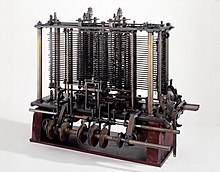
Back Analytical Engine ALS محرك تحليلي Arabic Analitička mašina BS Màquina analítica Catalan Analytický stroj Czech Analytical Engine German Αναλυτική μηχανή Greek Máquina analítica Spanish موتور تحلیلی Persian Analyyttinen kone Finnish

| History of computing |
|---|
 |
| Hardware |
| Software |
| Computer science |
| Modern concepts |
| By country |
| Timeline of computing |
| Glossary of computer science |
The analytical engine was a proposed digital mechanical general-purpose computer designed by English mathematician and computer pioneer Charles Babbage.[2][3] It was first described in 1837 as the successor to Babbage's difference engine, which was a design for a simpler mechanical calculator.[4]
The analytical engine incorporated an arithmetic logic unit, control flow in the form of conditional branching and loops, and integrated memory, making it the first design for a general-purpose computer that could be described in modern terms as Turing-complete.[5][6] In other words, the structure of the analytical engine was essentially the same as that which has dominated computer design in the electronic era.[3] The analytical engine is one of the most successful achievements of Charles Babbage.
Babbage was never able to complete construction of any of his machines due to conflicts with his chief engineer and inadequate funding.[7][8] It was not until 1941 that Konrad Zuse built the first general-purpose computer, Z3, more than a century after Babbage had proposed the pioneering analytical engine in 1837.[3]
- ^ "Babbage's Analytical Engine, 1834–1871. (Trial model)". Science Museum. Retrieved 23 August 2017.
- ^ Graham-Cumming, John (4 October 2010). "The 100-year leap". O'Reilly Radar. Retrieved 1 August 2012.
- ^ a b c "The Babbage Engine: The Engines". Computer History Museum. 2016. Retrieved 7 May 2016.
- ^ Bromley 1982, p. 196.
- ^ "Babbage". Online stuff. Science Museum. 19 January 2007. Retrieved 1 August 2012.
- ^ "Let's build Babbage's ultimate mechanical computer". opinion. New Scientist. 23 December 2010. Retrieved 1 August 2012.
- ^ Cite error: The named reference
meccanowas invoked but never defined (see the help page). - ^ Weber, Alan S (10 March 2000). 19th Century Science, an Anthology. Broadview Press. ISBN 9781551111650. Retrieved 1 August 2012.